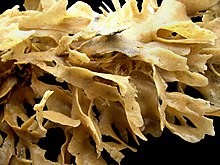Hornwrack
| Flustra foliacea | |
|---|---|
 |
|
| Scientific classification | |
| Kingdom: | Animalia |
| Phylum: | Bryozoa |
| Class: | Gymnolaemata |
| Order: | Cheilostomata |
| Suborder: | Flustrina |
| Family: | Flustridae |
| Genus: | Flustra |
| Species: | F. foliacea |
| Binomial name | |
|
Flustra foliacea (Linnaeus, 1758) |
|
| Synonyms | |
|
Eschara foliacea Linnaeus, 1758 |
|
Eschara foliacea Linnaeus, 1758
Flustra foliacea is a species of bryozoans found in the northern Atlantic Ocean. It is a colonial animal that is frequently mistaken for a seaweed. Colonies begin as encrusting mats, and only produce loose fronds after their first year of growth. They may reach 20 cm (8 in) long, and smell like lemons. Its microscopic structure was examined by Robert Hooke and illustrated in his 1665 work Micrographia.
Flustra foliacea was studied as early as 1665, when Robert Hooke published observations of various organisms and materials made with an early microscope. It was first given a binomial name in 1758, when Carl Linnaeus included it in the 10th edition of his Systema Naturae as Eschara foliacea. In later publications, Linnaeus divided bryozoans into more than one genus, and so the species came to be called Flustra foliacea. It is the type species of the genus Flustra.
Flustra foliacea is often mistaken for a seaweed, but is actually a colony of animals. The fronds can reach a height of 20 centimetres (7.9 in) and have rounded ends. They have a strong aroma of lemons. It differs from the superficially similar Securiflustra securifrons by the tendency of the frond branches to become markedly wider towards the tip. Each zooid is roughly rectangular, with 4–5 short spines at the distal end and 13–14 tentacles around the lophophore.
...
Wikipedia
